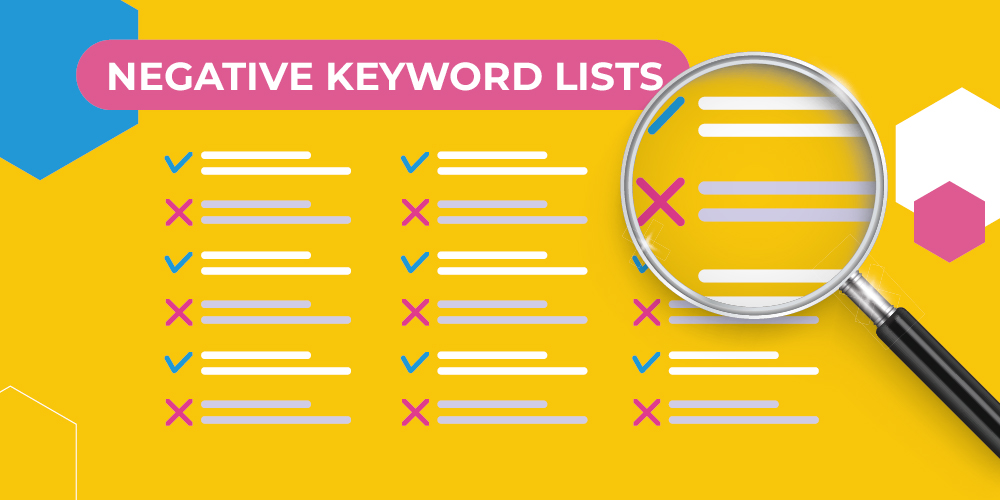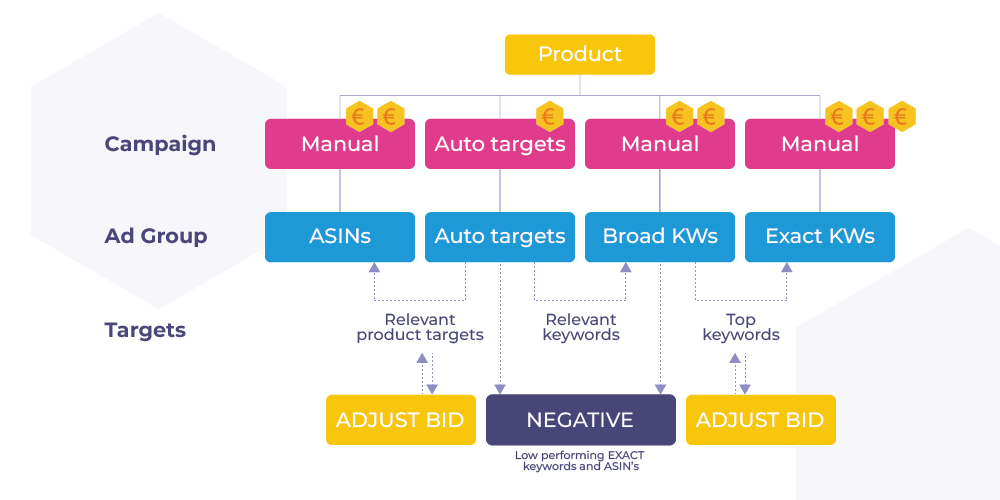The Ultimate Guide to Setting Up An Amazon PPC Campaign Structure


Your Amazon PPC campaign structure determines where your ads are located, who is likely to view them, and how much of your budget they’ll take up. With Channable’s end-to-end solution, you can optimize your campaigns, creating a structure that delivers on all your eCommerce marketing goals.
The importance of Amazon Ads should be common knowledge by now for most eCommerce brands. Amazon has established itself as an eCommerce juggernaut, holding a market share of 37.8% in the US. What’s more, Amazon’s impressive eCommerce revenue is built on the backs of numerous small and medium-sized businesses, with over 60% of sales on Amazon coming from independent sellers.
Getting the most from Amazon Ads depends on a slightly different approach to what you may be used to with other ad platforms like Google Ads or Facebook Ads. To ensure your digital marketing strategy is as effective as possible when using the platform, one of the first things to get right is your Amazon PPC Campaign Structure.
What is the Amazon PPC Campaign Structure?
Your Amazon PPC Campaign Structure describes how you organize and manage your campaign. It determines how, when, and where your ads appear. A good Amazon PPC Campaign Structure is fundamental to providing your marketing efforts with transparency and control.
While there are certain aspects of Amazon Ads that are out of your control, such as the precise way that the eCommerce giant’s secretive algorithm works, digital marketers will find that there are still a number of things that they can control - and this is where a good Amazon PPC Campaign Structure comes in.
How to structure your Amazon PPC campaign for eCommerce success
Unfortunately, you can’t simply press a button, launch a single automatic Amazon Ads campaign, and watch the sales come rolling in. Instead, to achieve all your marketing objectives on Amazon, it’s likely you’ll need several different campaigns, each based around its own product set and boasting unique objectives.
To ensure you have optimized your Amazon Ads campaign, there are several Amazon ads best practices to follow. One of them is certainly getting your Amazon PPC Campaign Structure right. In order to do so, there are a few terms worth getting to grips with before you get started. We’ve listed some of them below:
Automatic and Manual Targeting
Although automatic targeting is dismissed by some, in reality, both automatic and manual campaigns can play useful roles within your digital marketing strategy. Automatic targeting works by allowing Amazon to identify keywords based on the title, description, and other sections of your product listing. This means automatic targeting requires little manual input, but can deliver poor ad targeting - and poor ROI as a result.
Manual targeting, on the other hand, undoubtedly requires more effort in terms of keyword research, especially as your manual campaign could consist of more than one ad group, each requiring its own keywords. However, you could achieve higher ROI in return for your efforts.
Rather than deciding whether an automatic or manual approach is right for your Amazon PPC Campaign Structure, it is possible to use both. In fact, automatic targeting can be hugely useful for finding the best-performing keyword search terms for a particular product. Then, you can leave manual targeting to focus on exact matches.
Bulk operations
As mentioned previously, your Amazon PPC Campaign Structure is not likely to consist of just a single campaign. When working with multiple campaigns, making adjustments can be a lengthy process if you decide to do everything manually. With bulk operations, however, you can alter bids and keyword placements for multiple campaigns simultaneously, helping you maintain a standardized structure.
Remember, however, just because it’s possible to make adjustments to multiple keywords at once, this doesn't mean you should necessarily use as many keywords as possible. For instance, our recent interview with Jeff Cohen, an Amazon Tech Evangelist, highlights that no two campaign structures are the same. When developing Sponsored Products campaigns, he advises using no more than 5-10 initial keywords per campaign.
Negative Keyword Creation
Negative keywords describe those that are either irrelevant to your campaign or unlikely to lead to conversion. Including negative keywords is important for a well-performing Amazon PPC Campaign Structure, as they prevent you from wasting bids on irrelevant traffic.
Good negative keywords to include in your campaign structure might include competitor brands, misspellings, or anything else that you think won’t deliver good ROI. However, don’t be too hasty when creating negative keywords. Use keyword analysis to ensure that a term isn’t relevant before you dismiss it.
Powerful If/Then Rules
Amazon recently launched rule-based bidding, where users set manual conditions based on if/then rules. This allows Amazon to automatically adjust bids whenever certain conditions are met. This could mean keeping a close eye on performance metrics, increasing bids for high-converting keywords or decreasing bids for underperforming ones. Note that with Channable’s Amazon Ads connection, it’s possible to create dynamic sponsored product ad campaigns for Amazon easily using automation rules, like the if/then feature.
Dynamic Campaign Settings
Just because your eCommerce marketing strategy stands to benefit from an effective Amazon PPC Campaign Structure, this doesn’t mean it should be overly rigid. In fact, dynamic campaign settings should play a part within your structure to ensure your campaigns are flexible enough to adapt to changing customer behaviors or market conditions.
With sponsored product ads, it’s possible to activate dynamic bids so your bid will be increased or lowered based on the likelihood of a click converting into a sale. This is what happens when you choose “Dynamic Bid – Up And Down” from the settings menu, however, it is also possible to set your campaign to “Dynamic Bid-Down Only” if you simply want to ensure your ad doesn’t appear in searches for irrelevant products.
Use your Amazon PPC Campaign Structure to Supercharge your Marketing Strategy
Don’t expect your Amazon marketing strategy to deliver results automatically. There are automation features, of course, to help you improve your structure, but it still requires work. To be effective, an Amazon PPC campaign should be monitored to ensure it’s delivering the kind of return you expect.
At Channable, we understand the importance of your Amazon PPC campaign structure. Last month, we launched a new Bid & Budget Optimization feature to ensure your campaigns focus on high-traffic keywords, make use of negative keywords, use product detail pages correctly, utilize automatic targeting, and monitor your results. And best of all, we can handle all this for you.
Part of Channable's end-to-end marketplace solution, Amazon Ads could be your ticket to a greater return on investment from your marketing strategy. Learn how to manage thousands of ads across the Amazon marketplaces and streamline every step of your campaign setup, data and optimization.
Channable offers an A-Z eCommerce solution tailored to your needs. Maximize visibility, boost sales, and simplify management with our intuitive platform.
Sign up for a demo today to find out more.
Want more like this?
Want more like this?
Insight delivered to your inbox
Keep up to date with our free email. Hand picked whitepapers and posts from our blog, as well as exclusive videos and webinar invitations keep our Users one step ahead.
By clicking 'SIGN UP', you agree to our Terms of Use and Privacy Policy


By clicking 'SIGN UP', you agree to our Terms of Use and Privacy Policy
Other content you may be interested in
Categories
Categories
Categories

Want more like this?


Want more like this?
Insight delivered to your inbox
Keep up to date with our free email. Hand picked whitepapers and posts from our blog, as well as exclusive videos and webinar invitations keep our Users one step ahead.
By clicking 'SIGN UP', you agree to our Terms of Use and Privacy Policy












